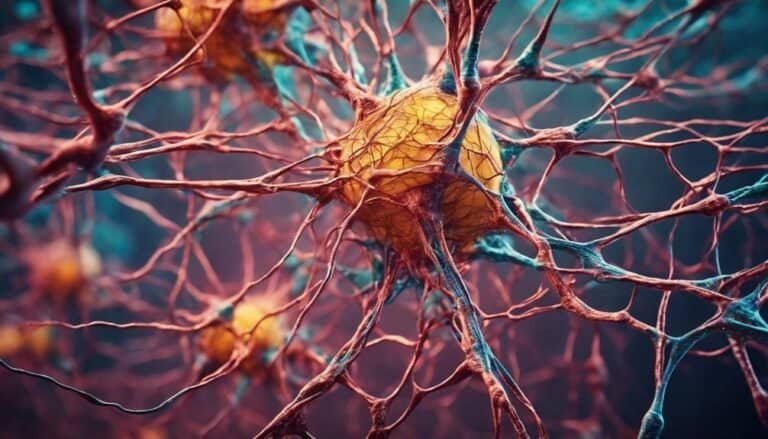Brain's Response to Fear and How to Overcome It
Imagine your brain as a vigilant guardian, always on the lookout for potential threats. But what happens when this guardian goes into overdrive, triggering a cascade of fear responses that seem uncontrollable?
Understanding how your brain reacts to fear is key to regaining control and finding ways to overcome its grip. By exploring the intricate interplay of neurotransmitters, the amygdala's pivotal role, and effective strategies to combat fear, you can start on a path towards reclaiming your peace of mind.
Key Takeaways
- Fear conditioning strengthens neural pathways associated with threats.
- Neurotransmitters like adrenaline influence fear processing.
- Techniques like diaphragmatic breathing aid in fear alleviation.
- Understanding the amygdala's role helps in overcoming fear responses.
Brain's Fear Response Mechanism
When faced with a threat, the brain's fear response mechanism swiftly activates to ensure survival. This mechanism is deeply rooted in fear conditioning, a process where the brain learns to associate a specific stimulus with a negative outcome. Through repeated exposure, such as encountering a dangerous situation multiple times, the brain forms strong connections within its neurological pathways that link the stimulus to fear. These pathways involve regions like the amygdala, which plays a crucial role in processing emotions, particularly fear.
Fear conditioning is essential for survival as it allows individuals to quickly recognize and respond to potential threats. When a threatening stimulus is encountered, the brain rapidly processes the information and triggers a cascade of physiological responses to prepare the body for fight or flight. Understanding how fear conditioning operates within the brain's intricate neurological pathways provides insight into why certain stimuli evoke fear responses and how these reactions can be modulated or overcome.
Impact of Fear on Brain
Fear exerts a profound influence on the brain's functionality and can significantly impact cognitive processes. When a threat is perceived, the brain initiates a complex series of events related to fear processing. This involves regions such as the amygdala, which plays a pivotal role in the brain's response to fear-inducing stimuli. Brain chemistry is also heavily involved in the impact of fear on cognitive functions. Neurotransmitters like adrenaline and cortisol are released in response to fear, affecting attention, memory, and decision-making processes.
Furthermore, fear can modulate neural circuits involved in emotional regulation and stress responses. Chronic fear or anxiety can lead to alterations in brain structure and function, potentially contributing to mental health disorders. Understanding how fear influences the brain's chemistry and processing is crucial for developing strategies to mitigate its negative effects. By learning to regulate fear responses, individuals can enhance their cognitive resilience and overall well-being.
In upcoming sections, we'll delve deeper into the role of neurotransmitters in fear modulation.
Neurotransmitters and Fear
Neurotransmitters play a crucial role in the brain's response to fear. They act as chemical messengers that transmit signals between neurons, influencing how fear is processed and perceived.
Understanding these neurotransmitters can provide insights into the mechanisms involved in overcoming fear.
Neurotransmitters in Fear
A complex interplay of various neurotransmitters modulates the brain's response to fear, influencing both the perception and processing of threatening stimuli.
Serotonin imbalance, a neurotransmitter involved in mood regulation, can impact how the brain interprets fear. Low levels of serotonin may contribute to heightened anxiety responses, making individuals more susceptible to fear-inducing stimuli.
Conversely, dopamine release, another key neurotransmitter, plays a role in reward-motivated behavior and can influence the processing of fear-related information. When dopamine levels are dysregulated, it may lead to alterations in fear learning and memory.
Understanding the intricate balance of neurotransmitters involved in fear responses provides insights into how different chemical signals within the brain contribute to the experience and management of fear.
Brain's Fear Response
The modulation of neurotransmitters in the brain intricately governs the response to threatening stimuli, impacting how you perceive and process fear.
When facing fear-inducing situations, your brain releases neurotransmitters like adrenaline and cortisol, triggering the fear response. Adrenaline heightens your senses, preparing your body for a fight-or-flight response, while cortisol helps regulate stress. These neurotransmitters increase heart rate, sharpen focus, and enhance overall vigilance to potential threats.
To manage fear effectively, techniques like deep breathing, mindfulness, and cognitive reframing can help regulate neurotransmitter levels. Deep breathing calms the nervous system, reducing the impact of adrenaline, whereas mindfulness promotes awareness and reduces the effects of cortisol. Cognitive reframing helps reevaluate fearful situations, altering neurotransmitter responses and aiding in fear management.
Overcoming Fear Mechanisms
Understanding the intricate interplay of brain chemicals in response to fear is crucial for effectively overcoming fear mechanisms. Two key processes involved in this are fear conditioning and fear extinction. Fear conditioning is the association of a neutral stimulus with a fearful event, leading to a learned fear response. On the other hand, fear extinction involves the gradual decrease in the fear response when the feared stimulus is repeatedly presented without any negative consequences.
| Process | Description | Example |
|---|---|---|
| Fear Conditioning | Learning to associate a neutral stimulus with a fearful event, leading to a fear response. | A dog becoming fearful of thunder after a loud noise. |
| Fear Extinction | Gradual decrease in fear response when the feared stimulus is presented repeatedly without any negative consequences. | A person overcoming a fear of heights through exposure therapy. |
Amygdala's Role in Fear
Within the brain, the amygdala plays a crucial role in processing fear responses. This almond-shaped structure, located deep within the temporal lobe, is involved in the detection and response to threats in the environment. When faced with a potential danger, the amygdala becomes activated, triggering a cascade of physiological and behavioral responses aimed at ensuring survival.
One of the key functions of the amygdala is fear conditioning. This process involves associating a neutral stimulus with a negative outcome, leading to the development of a fear response towards that stimulus. Through fear conditioning, the amygdala learns to recognize and react to potential threats, helping the individual to avoid harm in the future.
Studies have shown that individuals with damage to the amygdala exhibit deficits in fear processing, highlighting the critical role of this brain region in the experience of fear. Understanding how the amygdala contributes to fear responses can provide valuable insights into the mechanisms underlying anxiety disorders and other conditions characterized by excessive fear and avoidance behaviors.
Strategies to Combat Fear
To combat fear, utilize breathing techniques and visualization exercises.
By slowing down your breath and focusing on deep, rhythmic inhalations and exhalations, you can activate the body's relaxation response, calming the fear response in the brain.
Visualization techniques involve imagining a serene, safe place or a positive outcome, redirecting the brain's focus away from fear-inducing stimuli.
Breathing Techniques for Fear
Utilize controlled breathing techniques as a practical method to alleviate fear responses effectively. Controlled breathing helps regulate the body's stress response, promoting a sense of calm and reducing the intensity of fear.
Here are three breathing techniques to aid in fear alleviation:
- Diaphragmatic Breathing: Focus on breathing deeply, allowing your diaphragm to expand fully as you inhale and contract as you exhale. This technique promotes relaxation by engaging the body's natural relaxation response.
- Box Breathing: Inhale for a count of four, hold for four, exhale for four, and hold for four before repeating. This method helps synchronize breathing and calm the mind.
- 4-7-8 Breathing****: Inhale for a count of four, hold for seven, exhale for eight. This technique can quickly reduce anxiety and fear by promoting deep relaxation.
Visualization for Fear Relief
Visualization techniques offer a powerful tool in combating fear by harnessing the mind's ability to create calming mental images. Guided imagery involves picturing a specific, peaceful scene to redirect your focus from fear. Positive visualization, on the other hand, encourages envisioning a successful outcome or a sense of security to counteract negative thoughts. By engaging in these practices, you can train your brain to respond differently to fear-inducing stimuli, promoting a sense of control and relaxation.
| Guided Imagery | Positive Visualization |
|---|---|
| Picture a serene beach with gentle waves lapping the shore. | Visualize yourself confidently facing your fear and emerging victorious. |
| Imagine a lush forest with sunlight filtering through the leaves. | Envision a shield of light surrounding you, providing protection and strength. |
| Envision a clear blue sky with fluffy clouds floating by. | Picture yourself overcoming challenges with ease and grace. |
Cognitive Techniques for Fear
Implementing cognitive techniques can significantly aid in managing and reducing fear responses within the brain. When faced with fear-inducing situations, utilizing cognitive strategies can help reframe thoughts and emotions, leading to a more controlled response.
Here are three effective cognitive techniques for fear:
- Positive Affirmations: By repetitively reciting positive statements about yourself or the situation, you can counteract negative thoughts and instill confidence. Affirmations like 'I am strong and capable' or 'I can handle this challenge' can rewire your brain to focus on empowerment rather than fear.
- Cognitive Restructuring: This technique involves identifying and challenging irrational or negative thoughts that contribute to fear. By replacing these thoughts with more rational and positive ones, you can change your perception of the situation and reduce fear triggers.
- Reality Testing: Actively evaluating the evidence supporting your fears can help you gain a more realistic perspective. By questioning the validity of your fears and examining alternative explanations, you can diminish their intensity and regain a sense of control.
Mindfulness Practices for Fear
To address fear from a different perspective, exploring mindfulness practices can offer valuable insights into managing and navigating through fear responses in the brain. Mindfulness practices involve being fully present in the moment, acknowledging your thoughts and feelings without judgment. By incorporating mindfulness into your daily routine, you can learn to observe your fear responses without getting entangled in them, leading to fear relief and reduced anxiety levels.
One effective mindfulness practice for fear relief is engaging in deep breathing techniques. By focusing on your breath, you can calm your nervous system and bring your attention back to the present moment, reducing the intensity of fearful thoughts. Another beneficial practice is body scan meditation, where you systematically focus on different parts of your body, releasing tension and promoting relaxation.
Below is a table outlining some mindfulness practices for fear relief:
| Mindfulness Practice | Description |
|---|---|
| Deep Breathing | Inhale deeply through your nose, exhale slowly. |
| Body Scan Meditation | Focus on each part of your body, releasing tension. |
| Loving-Kindness Meditation | Cultivate feelings of compassion towards yourself and others. |
| Mindful Walking | Pay attention to each step and the sensations of walking. |
| Guided Imagery | Visualize peaceful scenes to calm the mind. |
Conclusion
In conclusion, understanding the brain's response to fear is crucial in overcoming it. By utilizing cognitive techniques and mindfulness practices, individuals can rewire their brain's fear response.
For example, a study found that individuals who regularly practiced mindfulness meditation showed reduced activation in the amygdala, leading to decreased fear response.
By actively engaging in these strategies, you can take control of your fear and lead a more fulfilling life.







